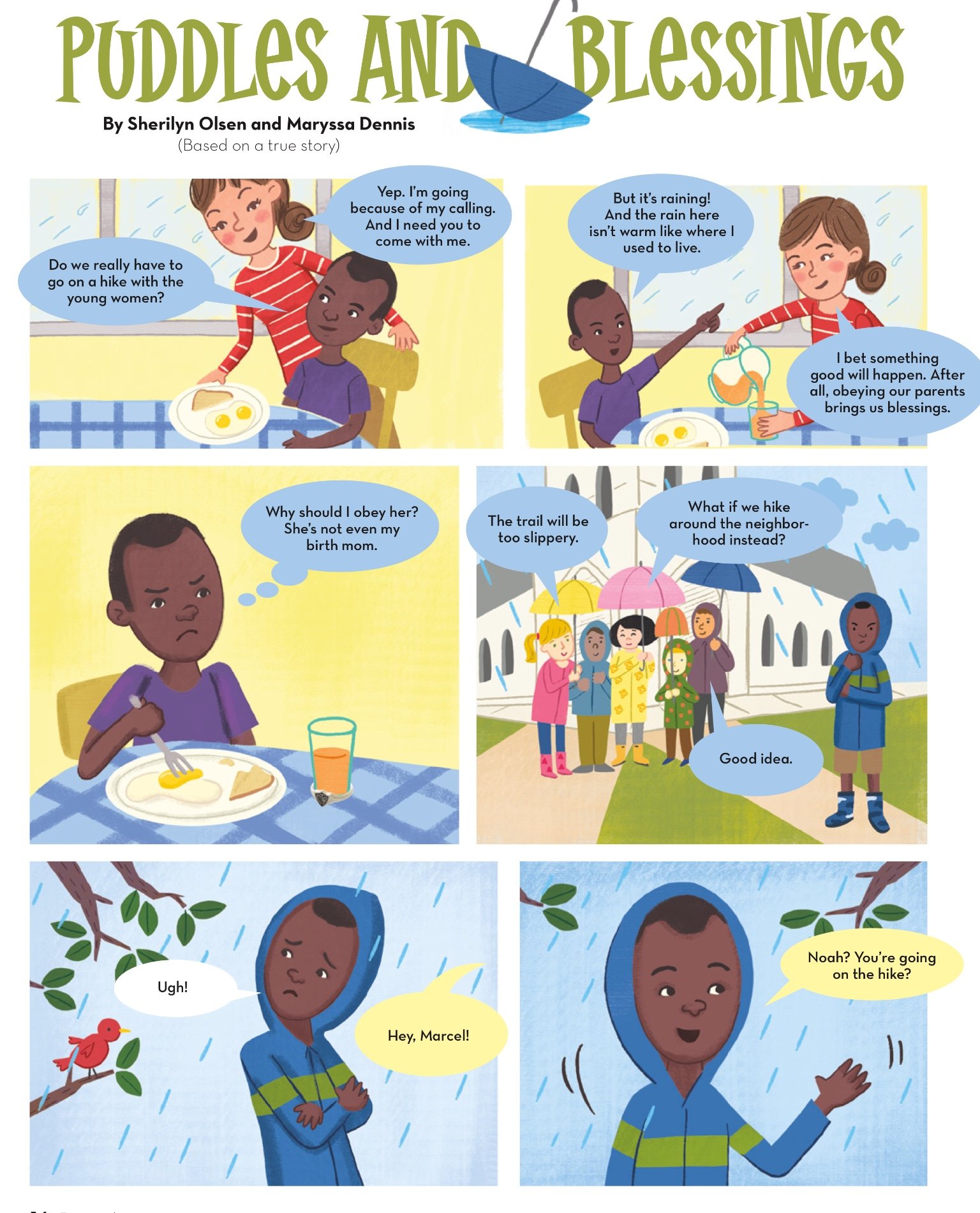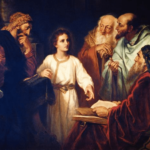[ad_1]
Keeping the commandments will help me know they are true. (Younger Children)
New Testament Seminary Student Manual (2023) “John 7” During the Feast of Tabernacles in Jerusalem, Jesus explained how anyone could know for themselves that the doctrine He taught was from Heavenly Father. The Feast of Tabernacles (also called the Feast of Booths or Huts) began and ended on a Sabbath and so was eight days long. Part of this celebration included building temporary huts made from tree branches. People stayed in these huts during the feast to remind them that God blessed His people for 40 years while they lived in the wilderness of Sinai.
Come, Follow Me—For Primary: New Testament 2023 “John 7-10” Jesus taught that we can gain a testimony of the truths He shared as we live them. The peace we feel when we obey the commandments helps us know they are true. Consider how you might teach the children this truth.
- Summarize John 7:17 in words the children will understand. Help them know that obeying the commandments helps us feel closer to Jesus Christ. For example, you could sing together a song like “Keep the Commandments” or “Choose the Right Way” (Children’s Songbook, 146–47, 160–61). Ask the children to listen for how we will be blessed when we keep the commandments.

- Share an experience when you gained a testimony that a commandment was from God because you lived that commandment, such as paying tithing or forgiving someone who was unkind. Invite the children to think of an experience they had when they obeyed a commandment. Ask them to share how they felt when they obeyed.
Friend August 2018 “Puddles and Blessings” Marcel doesn’t want to go on a hike in the rain with his mom and the Young Women. His mom tells him something good might happen because there are blessings from obeying parents. At the hike he finds that his friend Noah is there and they have a blast playing in puddles together.


Friend February 2015 “The Blessing Quest” Nathan wants to ride bikes with his friends instead of going to church, but he learns that commandments are meant to help us be happy. He goes to church and is blessed.
- Ask the children to draw pictures of themselves obeying a commandment. (Help them think of examples.) Invite them to share their pictures with each other and talk about the happiness they get from obeying that commandment.
Keeping the commandments will help me know they are true. (Older Children)
You and the children you teach may have had experiences living gospel truths and learning that they are true. How can you build on those experiences as you teach?
- Write each verse of John 7:14–17 on different pieces of paper, and display them in random order. Ask the children to put them in the correct order and check John 7:14–17 to see if they are right. Invite the children to split into pairs and share their understanding of each verse with their partner. How has obedience to God’s commandments helped them know the commandments are true?
- Share examples from the scriptures showing how people were blessed for living gospel truths, such as Daniel (see Daniel 6) or Elisabeth (see Luke 1:5–14). What blessings have we been given for obeying commandments?
- A few days before class, invite one of the children to write about a time when he or she gained a testimony of a commandment by living it. During class, ask the child to share what he or she wrote.
Come, Follow Me—For Sunday School: New Testament 2023 “John 7-10”
- In some ways, gaining a testimony is like learning a skill—both require practice and experience. To illustrate this, you could invite class members who have a particular skill, such as juggling or playing a musical instrument, to explain how they developed their skill. Why isn’t it enough to read about the skill or watch someone else perform it? As a class, discuss how the effort involved in practicing a skill is similar to the spiritual pattern the Savior described in John 7:14–17. How is it different?
- Perhaps class members could share experiences in which living a gospel truth helped them gain a testimony of it. Give class members time to think of a gospel principle they would like to gain a stronger testimony of, and then encourage them to set specific goals to live that principle more fully.
New Testament Seminary Student Manual (2023) “John 7”
John 7:39 Why did John say that “the Holy Ghost was not yet given”?
John referred “only to the gift of the Holy Ghost not being present, since the power of the Holy Ghost was operative during the ministries of John the Baptist and Jesus; otherwise no one would have received a testimony of the truths that these men taught [ Matthew 16:16–17 ; see also 1 Corinthians 12:3 ]” (Bible Dictionary, “ Holy Ghost ”).
Surely, the Savior did not condone [sin. But He also did not condemn the woman. He encouraged her to reform her life. She was motivated to change because of His compassion and mercy. The Joseph Smith Translation of the Bible attests to her resultant discipleship: “And the woman glorified God from that hour, and believed on his name” [Joseph Smith Translation, John 8:11 (in John 8:11 , footnote c)].
(Dale G. Renlund, “Our Good Shepherd,” Ensign or Liahona, May 2017, 30)
New Testament Coloring Book “Jesus Tells Woman to Sin No More”
Come, Follow Me—For Sunday School: New Testament 2023 “John 7-10” Sometimes we aren’t aware of ways in which we judge others. Here’s an activity to help class members overcome this tendency: Ask the class to help you create a list of ways we judge people (on their appearance, their behavior, their background, and so on). Give class members pieces of paper cut in the shape of a stone, and ask them to select a way of judging others that they feel they are guilty of and write it on a paper stone. What do we learn from the Savior’s words to the Pharisees in John 8:1–11? Invite the class to write on the other side of their paper stones something that will remind them not to judge (perhaps a phrase from John 8).
President Dallin H. Oaks of the First Presidency taught, “In this context, the word condemn apparently refers to the final judgment.” President Oaks further explained that Jesus did not condone the woman’s sin, but He was allowing her time to repent and acknowledging that her final judgment would come later:
Jesus obeyed His Father.
Jesus Christ always did things that pleased His Father in Heaven. How can you help the children find ways to follow His example?
- Help the children repeat what Jesus said about Heavenly Father in John 8:29: “I do always those things that please him.” Ask them to share things Jesus did that made Heavenly Father happy. Show them some pictures from the Gospel Art Book to give them ideas.
- Ask the children what makes them happy. Or invite a parent of one of the children to share an experience when the child did something that made the parent feel pleased, or happy. What can we do to make Heavenly Father happy? Invite the children to draw pictures of themselves doing those activities to take home and remind them.
“Lesson 18: Jesus Christ Heals a Man Born Blind,” Primary 7: New Testament (1997), 60–62
Obedience can make me free.
Some people think that living the gospel restricts them. How can you use John 8:31–36 to help the children understand that living the gospel actually makes us free?
- Invite the children to read John 8:31–36 and share what they think it means to be a servant of sin. How do the teachings of Jesus help us be free?
- Show a lock to represent sin and a key to represent how truths of the gospel can make us free. For example, knowing about the Savior’s Atonement can give us freedom to repent and be forgiven of our sins. Or knowing about the Word of Wisdom can give us freedom to avoid addictions.
Jesus knows me and loves me.
The parable of the good shepherd can help the children understand that Jesus loves them and knows who they are.
- Give the children pictures that represent something in the parable of the good shepherd, like sheep, a shepherd, or a wolf. Select some verses from John 10:1–16 to read to the children, and ask them to hold up their pictures when they hear you read about the things in their pictures. Help the children think of ways Jesus is like a shepherd to us. Bear your testimony that the Savior loves us and will guide us back to Him.
- Show the picture of Jesus and the lambs in this week’s outline in Come Follow Me—For Individuals and Families. How do we know Jesus loves the lambs? How can we tell that the lambs love Jesus? How can we show Jesus that we love Him?
Friend June 2018 “Apostles Testify of Jesus” “Shepherds lead their sheep to food, water, and shelter and protect their sheep from harm. Jesus taught that He is the Good Shepherd. When we choose to follow Him, He can lead us to safety and peace. Lead the sheep safely home through the maze!”
Jesus Christ is the Good Shepherd. We are His sheep, and He loves each of us. Ask the children how they know Jesus loves children.
Make paper sheep, write on them the names of the children in the class, and hide them around the room. Display a picture of the Savior, and read Doctrine and Covenants 50:41–42. Help the children understand what these verses teach about how Jesus Christ feels about them. Let them find the sheep around the room and put them on the board near the picture of Jesus so “none of them … shall be lost” (verse 42).
- Make a matching game using phrases from Doctrine and Covenants 50:40–46. For instance, you could write “Fear not, little children” on one card that would match with another card that says “for you are mine” (verse 41). Read Doctrine and Covenants 50:40–46 together. Then mix up the cards on the floor, a table, or the board, and ask the children to match the phrases. What do these phrases teach us about Jesus Christ?
- To help the children understand how the Savior is like a good shepherd show the video “Jesus Declares the Parable of the Lost Sheep” and ask them to find something in the video that reminds them of what they read. How does Jesus rescue us? How can we be good shepherds to others?
Friend December 2020 “Sheep and Their Shepherd” When Elder Stanfill was young his job at the ranch was to take care of all the abandoned sheep babies. He would drive his little VW to the field and honk his horn and all the babies would run and jump in the car and he would take them to be fed. Just like the sheep knew the sound of that old Volkswagen, we can learn to hear Jesus’s voice. We will feel His love and learn to trust Him.
Friend April 2023 “Come, Follow Me Activities: The Good Shepherd“
Story: Shepherds take care of their sheep and keep them safe. Jesus Christ is our Shepherd. He said, “I am the good shepherd, and know my sheep” (John 10:14).
Song: “I Feel My Savior’s Love” (Children’s Songbook, 74–75)
Activity: Play a sheep guessing game! Pick one person to be the shepherd. Everyone else will be sheep. The shepherd closes their eyes while one sheep makes a baa sound. Have the shepherd guess which “sheep” made the noise. Talk about how Jesus knows each of us by name.
Latter Day Kids “The Lord is My Shepherd” Lesson ideas
Friend August 2022 “The Lord Is My Shepherd”

Friend April 2023 Come, Follow Me Activities for Little Ones Have your little ones look into a mirror. Tell them that Jesus knows their names, what they look like, what makes them happy, and what makes them sad. Help your little ones say, “Jesus knows me and loves me.”
“In Jesus’s time, the Palestinian shepherd was noted for his protection of his sheep. Unlike modern sheepherders, the shepherd always walked ahead of his flock. He led them. The shepherd knew each of the sheep and usually had a name for each. The sheep knew his voice and trusted him and would not follow a stranger. Thus, when called, the sheep would come to him. (See John 10:14, 16.)
- Show the children a picture of a lamb. Ask them to name some things a lamb needs to be safe and healthy, and encourage them to look in Psalm 23:1–4 for ideas. Then show a picture of a child. What do we need to be spiritually safe and healthy? Read together Psalm 23, and ask the children how the things the shepherd does in this psalm could be compared to what Jesus Christ does for us.


Jesus is like a shepherd to me.
As you study the parable of the good shepherd, look for truths it teaches about our relationship with the Savior. How will knowing these truths bless the children? (In this parable, the sheep of the Good Shepherd are those who hear His voice and follow Him.)
- Write good shepherd and hireling on the board. Explain that a hireling is someone who is hired to do a job for money. Ask the children to list differences they find in John 10:1–18 between a good shepherd and a hireling. Why would you want to follow the good shepherd rather than the hireling? How is Jesus like a shepherd to us? (Note: A hireling is someone whose primary motive for working is getting paid.)
What is the difference between the Good Shepherd and a hireling?
President Ezra Taft Benson (1899–1994) taught:
“At night shepherds would bring their sheep to a corral called a sheepfold. High walls surrounded the sheepfold, and thorns were placed on top of these walls to prevent wild animals and thieves from climbing over.
Sometimes, however, a wild animal driven by hunger would leap over the walls into the midst of the sheep, frightening them. Such a situation separated the true shepherd—one who loved his sheep—from the hireling—one who worked only for pay and duty.
The true shepherd was willing to give his life for the sheep. He would go in amongst the sheep and fight for their welfare. The hireling, on the other hand, valued his own personal safety above the sheep and would usually flee from the danger.
Jesus used this common illustration of [H]is day to declare that He was the Good Shepherd, the True Shepherd. Because of His love for His brothers and sisters, He would willingly and voluntarily lay down His life for them. (See John 10:17–18 .)
(Ezra Taft Benson, “A Call to the Priesthood: ‘Feed My Sheep,’” Ensign, May 1983, 43)
- Draw or show a picture of a door. Read together John 10:7–9, and ask the children how Jesus is like a door. According to verse 9, what blessings come to those who “enter in” the door? How do we enter the door that Jesus Christ provides us?
Why did Jesus say, “I am the door of the sheep”?
New Testament Seminary Student Manual (2023) “John 10” Shepherds in Israel stood at the entrance of a sheepfold and inspected each sheep as it entered, treating injuries as needed. After the sheep were gathered in the enclosure for the night, the shepherd would lie down to sleep in the entrance, barring the way so that predators or thieves could not hurt the sheep. The Savior’s statement “I am the door” makes clear that He was willing to “lay down [His] life for the sheep” ( John 10:7, 15) and that He ultimately will decide who will enter the kingdom of heaven. Using an image similar to a door, the Book of Mormon prophet Jacob declared that “the keeper of the gate is the Holy One of Israel” and that “he employeth no servant there” ( 2 Nephi 9:41).
Come, Follow Me—For Individuals and Families: New Testament 2023 “John 7-10”To involve family members in learning from the parable of the good shepherd, ask each of them to draw a picture of one of the following: a thief, a door, a shepherd, a hireling (a hired worker), a wolf, and a sheep. Invite them to read John 10:1–18, 27–29, and then discuss as a family what the Savior taught about the things they drew.
Additional Resources
News with Naylors “Week 18: Jesus Heals a Blind Man”

Please follow and like us:
[ad_2]
Source link

















You must be logged in to post a comment.